Solo for Clarinet in B flat
Interview with Vicky Wright: Performing the Solo for Clarinet
John Cage, Solo for Clarinet in B flat (page 121)
Vicky Wright
Introduction
The Solo for Clarinet is one of the busier parts of the Concert, and includes a wide range of unusual sounds. As far as is known, it has never been recorded as a solo piece, although its appearance in Philip Rehfeldt’s book on extended techniques, New Directions for Clarinet (1994), suggests that it is considered to be a well-known piece within twentieth-century clarinet repertoire.
Simple system clarinet
One (not immediately obvious) question that the Solo for Clarinet raises to performers is what kind of clarinet to play it on. In the US in the mid-50s, there were clarinets with two different keywork systems in use: the ‘simple’, or Albert system, and the ‘modern’, Boehm system, which is in common use in the US and UK today. Simple system clarinets were particularly popular among jazz clarinettists at the turn of the twentieth century in the US but continued to be used throughout the first half of the twentieth century (see Check Reeves, 2000; Tyle, 2000). If Albert Kaufman, the clarinettist for whom Cage wrote the part, was a jazz or Broadway musician like some of the other members of the orchestra, it is possible that he would have played on a simple system clarinet. In addition, several of the techniques (discussed below) suggest that they were written to be performed on a simple system clarinet.
Side keys
The side key instruction is used in around a fifth of the notes in the whole of the Solo for Clarinet. Cage writes: ‘A dotted line associated with a tone accompanied by any or all of the numbers, 1, 2, 3, means depress ½ way of side right hand keys. These may be numbered by the player’. This raises several questions: first, the Boehm system clarinet has four right-hand side keys and the simple system has three. While it is possible that the player was expected to choose any three of the four keys (and this was the approach taken by several of the clarinettists interviewed for this project), the half-depression of the key is more curious. Second, on the Boehm system, the side keys are not designed to be depressed half way: the mechanism only really works in a binary, open or closed position. Depressing the key halfway is possible, but difficult to execute consistently, and it results in an unstable, liminal sound. Again, it is possible that this is the desired outcome or that a greater variety of sounds are possible on the Boehm system with practice, but the side keys on the simple system are depressible half way. Third, the side keys on the simple system are positioned slightly lower down on the instrument, making them easier to reach with the right hand while playing other notes. What’s more, they are configured in a way that the player can depress one, two, or all three keys together with greater ease. It is not possible to be certain, but when considered together, these factors certainly point towards the simple system clarinet as a more obvious choice of instrument. This isn’t to say that the Solo for Clarinet couldn’t be performed on a Boehm system clarinet, but that it is an interesting possibility to consider if the player has access to a simple system instrument. Wright discusses the side keys in interview.
Dynamics
In addition to the use of different sized noteheads, which are indicative of either dynamics or durations of a sound, or both, the majority of sounds have dynamics assigned to them. Unlike the other woodwind and brass parts, the Solo for Clarinet is biased towards diminuendos and combinations of dynamics, these latter being a ‘combination of two or more’ crescendos and diminuendos. The player is free to choose the ‘intensity and duration’ of these, and the overriding character, then, is one of change and improvisation with respect to dynamics throughout the Solo.
Articulation
Cage is very detailed in his use of articulation in the Solo for Clarinet. In the instructions he specifies ‘All tones are to be played without tonguing unless accompanied by the indication, “T”’. This is the only part that includes this instruction (in fact, the Solo for Bassoon and Baryton Saxophone states the opposite: ‘All tones are to be played with tongue and vibrato unless indicated otherwise’; and in the Solo for Sliding Trombone some notes are combined with ‘T hard’ or ‘T soft’). This is a reversal of standard clarinet technique, since notes are usually tongued by default, and one player described the instruction as ‘perverse’. As clarinettist Andrew Sparling commented in interview, in standard practice ‘You basically aim not to make the tongue an integral part of the sound too much. Because it is not considered’. Exactly half of all pitched sounds are marked as to be played with the tongue.

In addition, Cage provides another articulation instruction that doesn’t appear in any other part: ‘No attack is indicated verbally’, which is another way of instructing the player to start the notes without the tongue (pictured, p. 124, line 3). Starting notes without the tongue means that simply the force of the breath is used (more of a ‘H’ sound than a ‘T’ or ‘D’ sound).
Elsewhere, Cage indicates flutter tongue and slap tongue, both of which would be familiar to a player today. Flutter tongue appears in several of the woodwind and brass parts in the Concert. Slap tongue was traditionally more of a jazz technique first used in the early twentieth century (Rehfeldt, 1994, 65). In the Concert it is only used in the Solo for Clarinet and Solo for Bassoon and Baryton Saxophone.
Trumpet embouchure
Another articulation technique which is unique to the clarinet part is the ‘trumpet embouchure’. Cage writes: ‘Tpt. emb. without mouthpiece means play without mouthpiece using trumpet embouchure’. This requires the player to remove the mouthpiece and buzz into the barrel using a brass embouchure. Normal fingerings are used with this technique, but the resultant pitch will vary from instrument to instrument.
Articulation of sustained sounds
The clarinet and the trumpet parts are the only wind instruments to include the following instruction, which appears in all of the string parts: ‘Tones [or, in the case of the trumpet, ‘notes’] given appreciable duration may be played constantly or intermittently’. Wright chose to play any long sounds she determined as continuous sounds.
Pitch
Sliding tones and microtonal slides
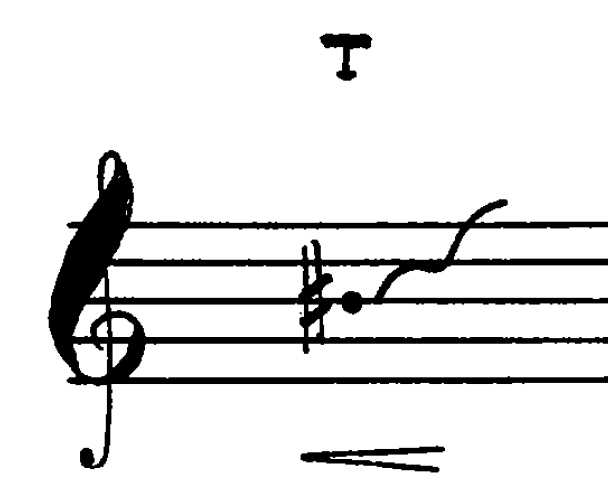
Sliding tones are a common feature across the instrumental parts. Cage writes ‘Curves following notes are sliding tones. They do not refer to time-length but only to direction in pitch’. Unlike some of the other parts, Cage does not use the word ‘gliss.’ in the clarinet part. In any case, the indication is more suggestive of a portamento effect than glissando. Here, the reduced keywork of the simple system allows for a smoother chromatic transition between pitches, because the instrument’s open holes afford greater microtonal flexibility.
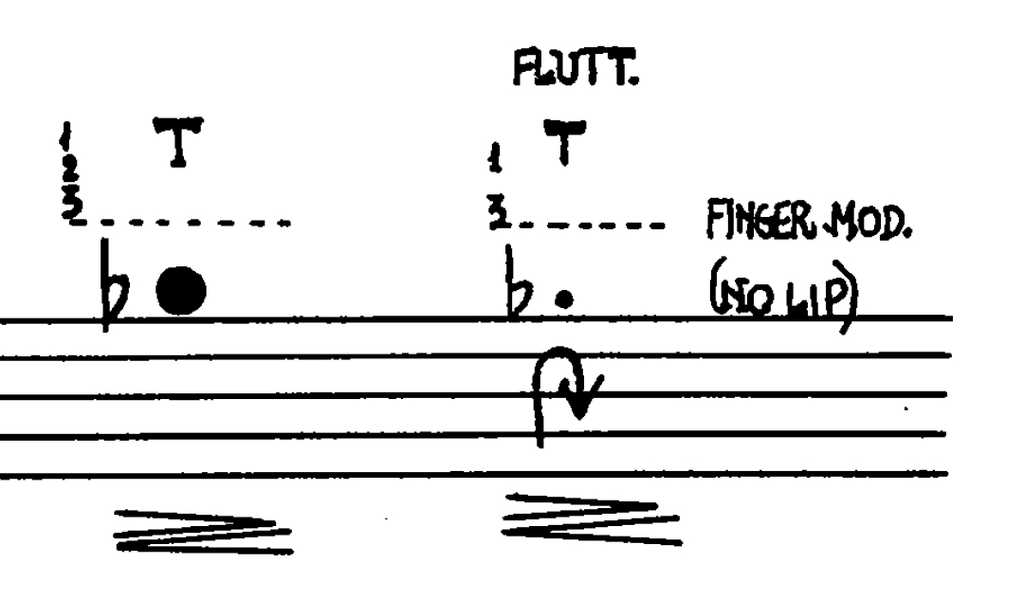
A similar technique to ‘sliding tones’ is the ‘microtonal slide’, which again is used in all of the woodwind and brass parts. However, the clarinet part additionally specifies ‘by use of the lip’ and adds instructions about the use of ‘finger modulation with or without lip’ (e.g., p. 121, line 5). The finger modulated microtonal slides (which for the most part move in an upward or combined direction) can be executed more easily with the simple system clarinet, for the same reason. Again, the ability to slide microtonally and smoothly is dependent on the player (a famous example of this flexibility is the combined glissando and portamento in the opening clarinet solo of Gershwin’s Rhapsody in Blue), but there are some specific examples in the part where a simple system clarinet would facilitate the sliding tones (e.g., p. 126, line 4, pictured).
Other techniques
Cage provides a wide range of suggestions for noises in the Solo for Clarinet, indicated with ‘Notes above or below a staff and attached to it by a line’. Unlike the Solos for flute, bassoon/saxophone, trumpet, and tuba he doesn’t suggest that the player can exchange these noises for noises of their own choice. This means that the clarinet part is the most specific of the woodwind parts. It also has the largest proportion of noise sounds to pitched sounds of all the Solos.
‘High squeeks’ [sic]
The ‘High squeeks’ instruction seems fairly self-explanatory, but it is left up to the player to decide how to produce the squeak. Sparling and Wright suggest achieving it by playing with the bottom teeth touching the reed (usually they would be covered by the lip).
‘High tones played softly producing undertones’
This effect is unique to the Solo for Clarinet. Undertones are a sound whereby the lower partials of a high note (in the clarino register or above) can be heard. Undertones are cited by Rehfeldt as an example of a ‘multiple sonority’ (1994, 41); similarly, Wright took the instruction to mean a multiphonic, and so she decided to use fingerings that would result in an unstable sound.
Tremolo
Tremolo is an effect which is only used in the clarinet and the bassoon/saxophone parts, and Cage specifies two different types to be used: ‘tremolos of any two tones within ranges indicated, sliding or not in pitch’. The effect is fairly straightforward to produce when used between two stable pitch ranges, but if it is used in combination with a ‘slide’ (e.g. line 2, p. 121), the performer must decide whether to slide between one or both of the pitches. The difficulty of sliding both pitches can result in a break in the sound (as can be heard in the recording, The Barton Workshop plays John Cage (1992)), adding to the catalogue of unstable sounds found in the Concert.
Mouthpiece sounds
‘Mouthpiece sounds’ are a common feature of all of the woodwind and brass parts in the Concert, but in the Solo for Clarinet Cage includes a number of additional options: ‘separate from the instrument with or without extension, lip and hand modulated, open and muted, or both’. Playing with just the mouthpiece allows more flexibility in pitch than when the full instrument is used. ‘Mouthpiece + extension (open)’ is the first noise to be used in Solo for Piano. Sparling and Wright take ‘extension’ to mean using the mouthpiece and barrel together creating a slightly lower, but stable, pitch range (Rehfeldt (1994, 71) also suggests that the barrel should be used). By contrast, clarinettist Ian Mitchell used his hand in a barrel-like shape to create an extension that gives him greater variability in pitch. As he commented during interview, ‘It could have been the barrel. But actually, and if you think also of the word “extension”: it implies to me something a bit different from part of the instrument. It is bringing something else in. An extension to your house is adding something to it’. Wright interpreted ‘open’ as left completely open, and ‘muted’ as covered slightly with her hand. To ‘modulate’ the sound, she inserted her finger into the barrel to bend the pitch, similar to a slide whistle effect. Mitchell also used his hand to mute the mouthpiece, but he varied the pitch by adjusting his hand into a cup-like shape, to generate different colours within the muted sound. He suggested using a separate mouthpiece and reed for this technique, to avoid spending time dismantling the instrument during the busier moments of the piece (e.g. p. 121, line 1).
‘Use of upper or lower ½ of the instrument with mouthpiece with free choice of tone or tones’
This technique can be categorised as one of several effects for wind instrument that involve dismantling the instrument in some way, however, playing the upper or lower half of the instrument using the mouthpiece is particular to the Solo for Clarinet only. This may be the first time that the effect has been used in a composition (see Rehfeldt (1994) for a discussion of later pieces to use the technique). Playing the mouthpiece and upper half of the instrument creates a similar pitch range, but with the lower notes slightly sharper. Using the lower joint results in a sequence of notes within an approximate range of B3 and F♯5.
‘Singing/gargling, apart from or into the instruments’
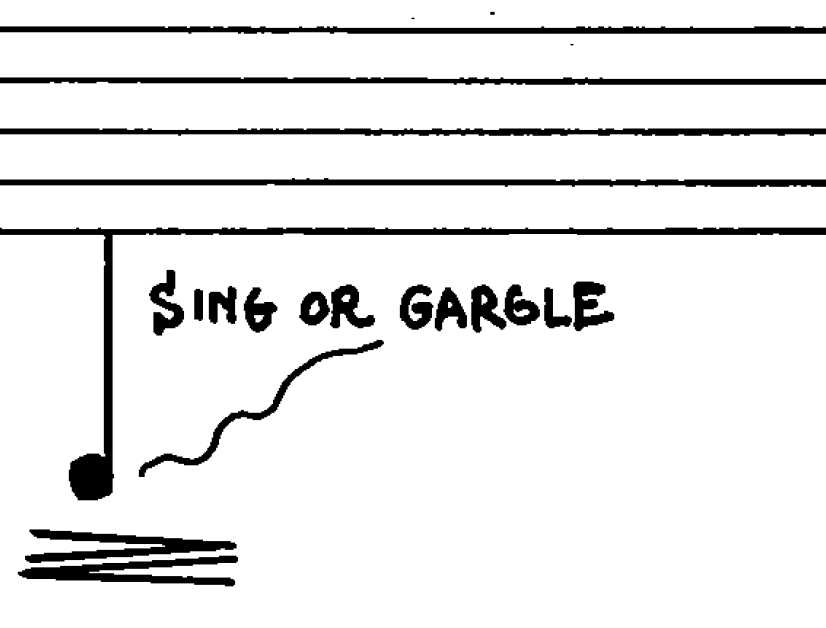
Cage provides instructions to sing in the clarinet and flute parts only, however, the clarinet is the only instrument for which gargling is an option. Sometimes the sound appears on its own, and sometimes it is accompanied with a sliding indication (e.g. p. 122, line 1), which suggests a manipulation of pitch. It is not clear whether ‘gargling’ means to gargle using liquid, or to make a gargling-like sound; as some players noted, it would be difficult to gargle with liquid into the instrument!
The player could decide to sing into the instrument in various ways. The option to sing apart from the instrument is perhaps one of the most open directions of the part, with seemingly endless possibilities in terms of pitches and sounds. As Sparling commented, ‘The difficulty with the singing is always that you’ve got to think of some sort of text even if it is only a vowel sound, and that’s presumably what he’s looking for. You wouldn’t want to start singing words, would you?’ The question raised by Sparling was also considered by other players. Mitchell felt similarly that singing a pre-composed melody or song would be ‘unjustified’ in this context. One option for singing could be to use the material provided by Cage in his Solo for Voice 1 and 2 (1960)—both of which can be performed in combination with the Concert—_as an example. The former provides text and vowel sounds, and the latter provides just vowel sounds. Wright chose to sing vowel sounds both into and away from the instrument. There are places where singing/gargling is combined with other techniques, e.g. side keys (p. 122, line 3), but this has no discernible effect on the resultant sound. For Sparling, the performance context influenced the decisions he made about singing. In interview he reflected on a performance of the _Concert with Apartment House with Lore Lixenberg singing Aria (1958), and in which he ‘felt slightly more encouraged to sing, because there was singing going on.’ (Clarinettist Heather Roche provides a comprehensive guide to singing and playing on her blog.)
Additional sounds
In addition to the noises indicated specifically by a note on a staff, Cage includes other sounds in the clarinet part. Quite often these involve disrupting or destabilising an existing tone by modifying the fingering configuration in some way. The side key instructions, discussed above in reference to the choice of instrument, are an example of this. Two other examples which appear exclusively in the clarinet part, and which together account for a fifth of the pitched sounds, are ‘°’ which Cage uses to indicate ‘thumbhole open’ and ‘Reg. key without th.-h’ (meaning ‘depress register key without thumbhole’). These modifications affect the pitch in various ways, often resulting in a liminal sound (e.g. the A3 and E3 on p. 121, line 3, played with the thumb hole open result in relatively similar flattened G4s). Sometimes this indication is applied to a note for which it has no effect, e.g. the A♭4 on p. 121, line 3.
‘Boat whistle’
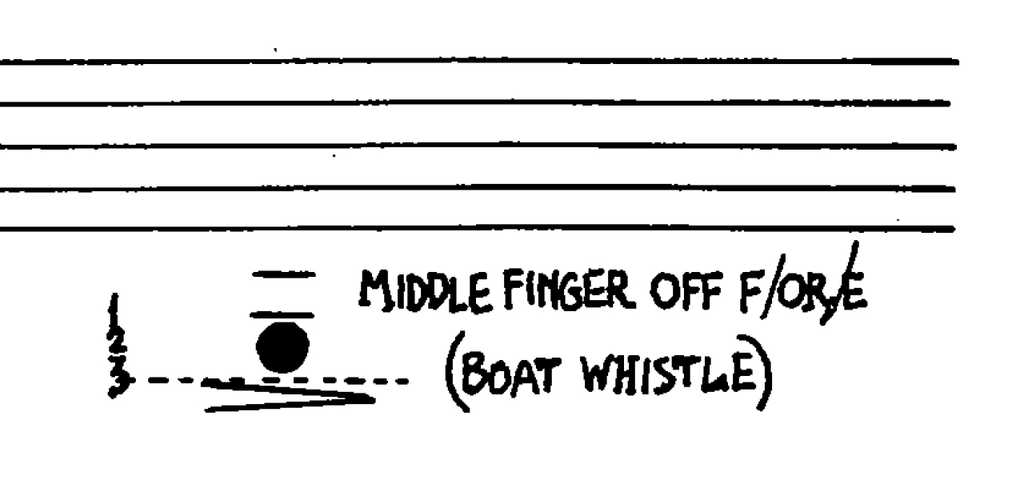
The ‘boat whistle’ technique is unique to the clarinet part and is described by Rehfeldt (1994) as ‘well known’, which is curious since the Solo for Clarinet has not been recorded as a solo piece and the Concert is not widely performed. This technique appears four times in the part, on the fingered notes of G3 and G3 with the instruction ‘Middle finger off F or E’. Since the middle finger doesn’t touch the F3 or E3 key, this instruction makes more sense if it is read as ‘Middle finger off. F or E’, suggesting that the effect is produced by removing the middle finger and depressing the F or E key. Though Cage doesn’t specify whether he means the right- or left-hand middle finger, the right-hand middle finger is the most obvious choice, since it results in a more immediate multiphonic sound.
‘An X means produce percussive tone by snapping fingernail against reed’
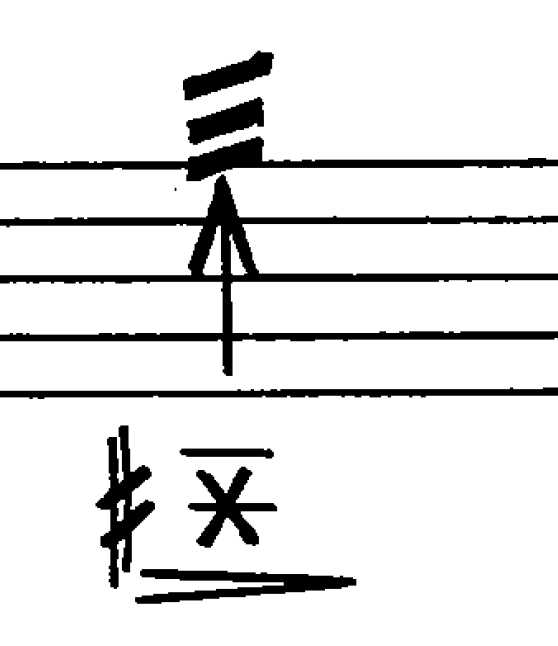
The fingernail on reed technique is indicated as a X notehead on the staff, and it appears on its own (e.g. p. 121, line 4), or in combination with other techniques, e.g. with a tremolo and microtonal slide direction (p. 122, line 4). It is the only ‘noise’ technique applied to a specific pitch. Perhaps the X is a wink at the X pizzicato technique in the string parts, where X means ‘stopped sideways against fingernail’? In any case, this technique is ambiguous (exactly how and where should the reed be tapped, for instance?), and a number of different approaches have been taken by players. Since the X appears on particular pitches, this suggests that the player should finger a note while producing the percussive effect, presumably without blowing at the same time, as the finger wouldn’t be able to reach the reed with the clarinet in the player’s mouth. It is used on six occasions, and always on pitches in the chalumeau register. Two instances require just the left hand (the G4 on p. 121, line 4, and the E4 on p. 122, line 4), which would leave the right hand free to tap the reed. However, the other four require both hands (the A♯3 on p. 121, line 2, G♭3 on p. 131, line 2, F3 on p. 132, lines 1 and 2). Some players were cautious about damaging their reeds, and suggested using a separate mouthpiece with reed attached, so as not to have a detrimental effect on the reed for the rest of the performance. However, this would remove the pitched element of the sound (although the sound is mostly percussive, fingering notes does have a slight effect on the pitch of the resonance, as in Wright’s demonstration shown below). Another suggestion was to ask a colleague to tap the reed on your behalf, which may or may not be practical, depending on the seating of the ensemble, and how busy the performance was at that point in time. Other players suggested trying to get as close as possible to the desired sound, which is what Wright did: in the video demonstration she effects a glissando with the left hand and taps the reed with the right.
‘A bar line means optional change of reed’
While sketches exist in the New York Public Library for a clarinet part with doubling bass clarinet, the Solo for Clarinet is the only part that doesn’t include an instruction to change instrument or to modify the instrument’s tuning system (i.e. the scordatura in the string parts) where bar lines are indicated (although the effect is achieved in the Solo for Sliding Trombone through various ways of dismantling the instrument). Instead, Cage invites the player to change reed where bar lines are indicated, with the Solo for Clarinet being the only part involving bar lines for which the change required is optional. This is quite a problematic demand for most clarinet players, since often a great deal of time is spent preparing and choosing the ‘best’ reed for a performance. As Sparling commented, ‘Basically that means that you’ll play on a dry reed that you haven’t warmed up on. So it won’t respond to what you’re trying to do’. It is possible that Cage understood that different strength reeds can result in different timbres, but that he wasn’t concerned with the technical implications of changing reed. Mitchell viewed this differently, suggesting that the instability in sound production created by the change of reed could have been Cage’s very intention! As Wright discusses in interview, she decided not to follow this instruction, as she didn’t find that it had a noticeable effect.
Combining techniques
Like the Solo for Trumpet, the Solo for Clarinet contains no sounds that have zero performance instructions of any kind. Each sound is directed to be manipulated in some way. While isolating each technique in the Solos enables a better understanding of the range and detail of techniques Cage used, the real character of each part is revealed in the ways various ways that these techniques are combined. Often one technique may affect another, make another inaudible, or combine with others to create unpredictable and unstable sounds. Performers must constantly navigate the range of options available to them in these cases and make choices as to what, and how, to prioritise in the execution of each sound. Wright demonstrates various combinations of sounds in the clarinet part in interview.
Acknowledgements
With thanks to Andrew Sparling and Ian Mitchell for their contributions about performing the clarinet part.
Bibliography
Deborah Check Reeves, ‘Albert and the Albert System’, The Clarinet, vol. 27, no. 2 (March, 2000), 30–32
Phillip Rehfeldt, New Directions for Clarinet [Revised edition] (Berkeley, CA: University of California Press, 1994 [1977])
Chris Tyle, ‘The Albert System in early jazz’, The Clarinet, vol 28, no. 1 (December, 2000), 74–75
Discography
The Barton Workshop Plays John Cage. Barton Workshop; Marianne Schroeder, piano (Etcetera, KTC 3002, 1992)
The works of John Cage are the copyright of Henmar Press Inc., New York and are reproduced by permission of Peters Edition Limited, London. All rights reserved.
